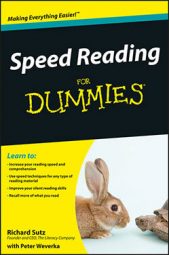See where you stand as a speed reader
If you’re challenging yourself to become a speed reader, you may be curious to know how you compare to others in the speed-reading department. (And who wouldn’t be?) Roughly speaking, readers fall into these categories where speed is concerned:
-
1 to 200 WPM (words per minute): You’re a talker. You read one word at a time at about the same speed as you talk and you may move your lips when you read. Most talkers are held back because they engage in vocalization while they read — they speak the words silently to themselves as they read them. Unless you’re an especially fast talker, reading at the speed you talk slows you down.
-
200 to 300 WPM: You’re an average reader, one who probably doesn’t enjoy reading as a hobby. You engage in some vocalization as you read, but you can read several words at once. Most people read at this speed.
-
300 to 700 WPM: You’re an above average reader who can read groups of words in a single glance, recognizing and reading phrases in sentences quickly. You vocalize a little when you read. You very likely have a large vocabulary.
-
700+ WPM: You’re a speed reader. You’re adept at reading 10 to 16 words at a glance, both horizontally and vertically on the page. You read with a great degree of confidence and agility.
So if you read 700 or more words per minute, take the rest of the day off. You don’t need speed-reading lessons — you’re already a fast reader.
Defining speed reading
Speed reading isn’t a whole different way of reading; it’s just a more focused way of reading. Reading engages the eyes, ears, mouth, and, of course, the brain. Speed reading engages these senses even more than normal reading because you use your senses and brain power even more efficiently.
Speed reading is…
-
Seeing: The first step in reading anything is seeing the words. With speed reading, you use your sight in specific ways:
-
You read several words in a single glance. Unless you’re encountering words you don’t know or haven’t read before, you don’t read words one at a time.
-
You expand your vision so that you can read and understand many words in a single glance. A very good speed reader can read, see, and process 10 to 14 words at once.
-
You expand your vision to read vertically as well as horizontally on the page. Speed readers can read and understand words on two or three different lines in a single glance.
-
-
Silent reading: Most people hear words when they read. You may speak words to yourself because you learned to read with the sound-it-out method. The problem with sounding out words when you read is that you read not at the speed you think but rather at the speed you talk. Sounding it out is fine for beginning readers, but at some point you have to dispense with sound if you want to be a speed reader. Saying the words, even if you only whisper them inside the confines of your skull, takes time and prevents you from reading as fast as you can.
-
Decoding the words: When you come across a word in your reading that you don’t know or recognize, you have to decode it. You break it into syllables, try to pronounce it, and see whether it’s related to words you know. You try to get its meaning, and if you can’t do that on your own, you consult a dictionary or other reference source. The more you read, the fewer words you have to decode because reading enlarges your vocabulary. It introduces you to more words.
-
Comprehending: The purpose of reading is to comprehend — to learn something new, see the world from a different perspective, or maybe just get information to pass an exam or prepare for a business meeting. How well you comprehend what you read is determined by your
-
Reading speed: When you don’t read at the right speed, your comprehension is diminished. One of the skills you acquire as a speed reader is knowing when to slow down and when to speed up. The fastest speed readers adjust the speed at which they read, just as the fastest stock car racers slow down when they’re in a crowded field or on a slick patch of roadway. They adjust their speed according to the type of reading they’re doing.
-
Breadth of vocabulary: Having a large vocabulary is a must for speed readers. You can’t get away from it.
-
Degree of familiarity with the subject matter: How strong a background you have in the topic you’re reading about determines how well you comprehend what you read. Obviously, you have a head start if you’re traveling in territory you’re familiar with and you know the jargon already.
-
-
Concentrating: All reading requires a certain amount of concentration. Speed reading, however, requires sustained, forceful concentration because when you speed read, you do many things at once. As you see and read the words on the page, you also remain alert to the main ideas that the author wants to present. You have to think along with the author and detect how she presents the material so you can pin down the main ideas.
As you read, you have to read with more perspective and separate the details from weightier stuff. You have to know when to skim, when to read fast, and when to slow down to get the gist of it.
Debunking speed-reading myths
You may have some preconceived ideas about what speed reading is. Don’t worry, many people have erroneous ideas about the practice of speed reading, including the myths in the following list, all of which are false:
-
You don’t enjoy reading as much when you speed read. On the contrary! Speed reading is efficient reading. When you speed read, you’re a better reader — you get more pleasure and meaning out of the books, articles, and Web pages that you read. Many people develop a love of reading only after they learn to speed read.
-
You don’t comprehend as well when you speed read. Speed reading is the act of reading with higher levels of concentration. What’s more, by reading several words at a time rather than one word after the other, your comprehension increases. You can read words in context and derive more meaning from the words you read.
-
You skip words when you speed read. Wrong again. Speed readers don’t fixate their eyes on all the words as they read, but that doesn’t mean they skip the words. Speed reading entails reading words in clumps, or groups. You read more than one word at a time, but no word gets skipped.
-
You have to run your finger down the page or use a pacer when you speed read. A pacer is a visual guide, such as your finger or a pen, that marks where you read on the page. Most people have a stereotypical image of a speed reader as a crazed-looking individual dragging his finger or a pacer quickly down the page in the act of reading. However, you don’t need a pacer to speed read. A pacer can be helpful in the early stages of speed reading, but you’re wise to abandon it after you get the hang of speed reading.
To make a pacer, cut a piece of blank paper to a size that’s comfortable for you, then cut a window out of the paper that’s the size you’d like to use (a small window if you want to see just one or two words, or a larger one if you’d rather see most of a sentence). See the following figure.

How to stop vocalizing and become a speed reader
Stopping yourself from vocalizing is an essential first step to becoming a speed reader. Vocalizing is hearing words as you read — you may even move your lips and quietly pronounce each word. If you’re saying or hearing every word, you’re reading at the speed you talk, not at the speed you think. Use these tips to kick your vocalization habit to the curb:
-
Read for meaning rather than sound. Reading without vocalizing has a lot in common with listening to someone speak. When someone speaks, you hear the words, but you only hear them in connection with whatever thoughts and ideas the speaker is trying to convey. The same is true of reading without vocalizing: You read words for meaning, not sound. You see the word on the page and respond to its meaning without the intermediary step of hearing the word’s sound. You don’t read the words as words — you read units of meaning (like ideas, thoughts, and descriptions) whose building blocks happen to be words.
-
Stop your vocalization motor, To prevent your lips from moving when you read and disengage your vocal system, try putting your mouth to work at something besides reading. Chew gum, or, if your lip movements are especially pronounced, place a pencil or pen between your lips as you read.
-
Silence your inner reading voice. Some techniques to try for training yourself to read without hearing your inner reading voice:
-
Try to perceive the words rather than see them. Imagine that each word is a symbol (not a sound) that conveys a meaning.
-
Turn off your ears. Pretend your ears have a volume control and turn it to the mute setting.
-
Widen your field of vision. By taking in more words on a line, you force yourself to read more words at a time, and this helps prevent vocalization.
-
Identify the thought units in sentences, not the words, and read thought unit by thought unit rather than word by word.
-
Concentrate harder when you read. Much of being a speed reader comes down to concentrating harder than you used to.
-

